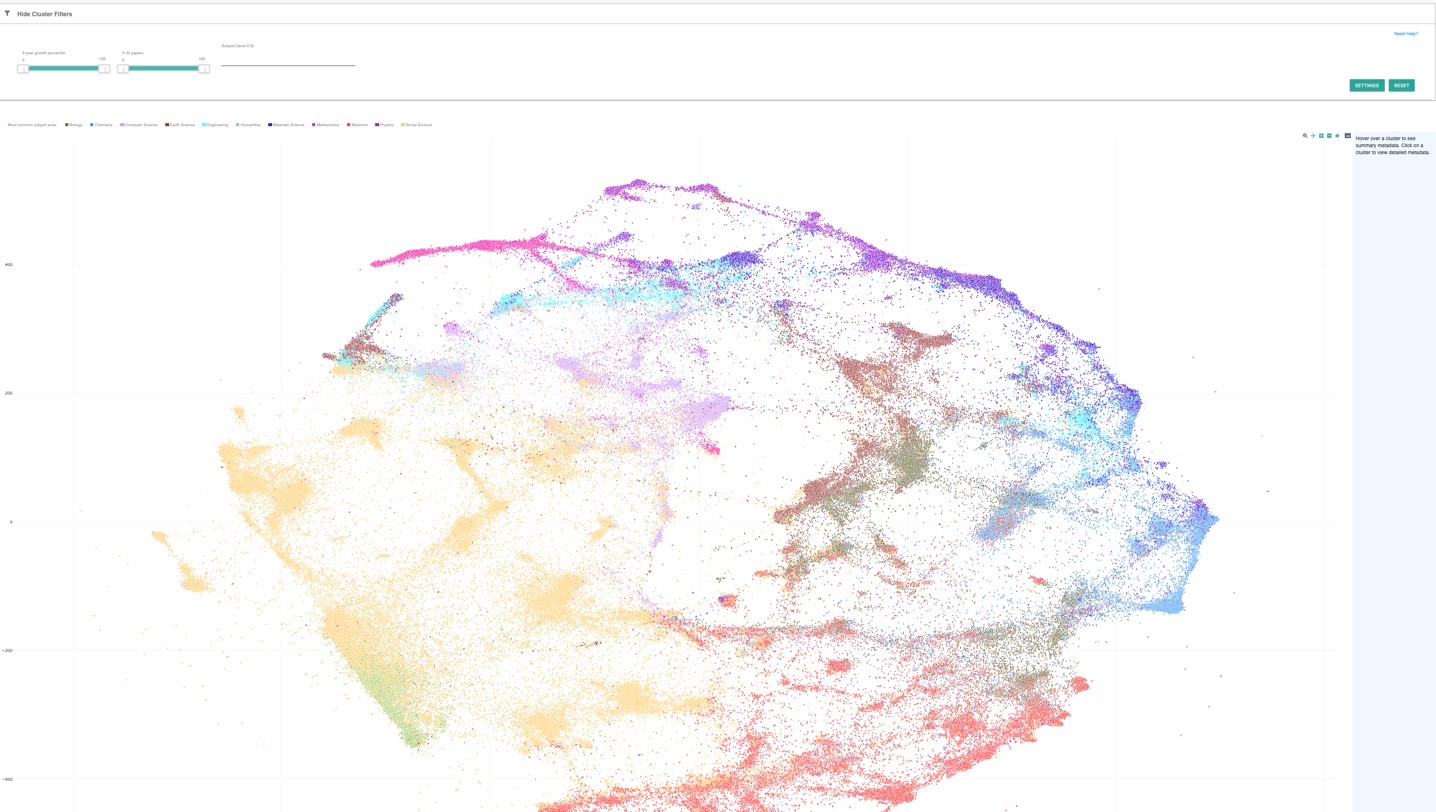Following the launch of CSET’s Map of Science user interface, we are going to dig into some interesting explorations enabled by the Map. First: the intersection of AI and COVID-19 research. In subsequent data snapshots, we’ll look at different subjects.
With the COVID-19 outbreak in December 2019, researchers and healthcare professionals looked to artificial intelligence (AI) and machine learning (ML) as important resources for advancements in detection, diagnosis, forecasting, and tracing.1 Government and industry organizations alike invested in AI/ML approaches to COVID-19 relief solutions.2 In December 2020, the National Institutes of Health (NIH) awarded more than $107 million to non-traditional COVID-19 research, with AI listed explicitly. 3
In an effort to understand how AI/ML has impacted the COVID-19 research literature, we identified research clusters (RCs) that were focused on COVID-19 by searching for mentions of “coronavirus” or “covid” in the main subject area. This filtering resulted in 307 RCs of interest. Out of 11 broad research areas, COVID-19 RCs fall under seven, with medicine and social science being most common, represented in Table 1.
Table 1. COVID-19 RCs Broad Area of Research
| Research Area | RC Count |
| Social Science | 231 |
| Medicine | 60 |
| Biology | 10 |
| Computer Science | 2 |
| Humanities | 2 |
| Chemistry | 1 |
| Materials Science | 1 |
Comparing the COVID-19 RCs by their concentration of AI-related papers (see Table 2), we find that the large majority (95%) have minimal AI-related research (i.e., fewer than 5% of papers in those RCs are AI related), while eight of the COVID-19 RCs contain over 10% of papers that are AI related.
Table 2. Breakdown of the 307 COVID-19 RCs by Their Percentage of AI-Related Papers
| Percentage of AI-Related Papers Bins | Number of RCs |
| [0%, 5%] | 292 |
| (5%, 10%] | 5 |
| (10%, 100%] | 8 |
| No AI % Assigned | 2 |
| Total | 307 |
Comparing the COVID-19 RCs by their concentration of AI-related papers, we find that the large majority (95%) have minimal AI-related research…
As examples of how AI is supporting COVID-19 research, we will highlight the two COVID-19 RCs with the highest percentage of AI-related papers that also have 50 papers or more in the last five years: RC 14353 and RC 60903.
RC 14353
The COVID-19 RC with the highest concentration of AI-related papers (74% of 2,026 papers from 2016-2021) is focused on analyzing chest CT and X-ray images of COVID-19 patients. Specifically, the main contribution of AI to this research is the implementation of computer vision image detection on CT scan and X-ray images for COVID-19 patients (see example paper). This RC has grown roughly 11,000% between 2020 and 2021 and falls under the main research category of computer science. India dominates this research cluster, with the United States and China in second and third place, respectively.
Specifically, the main contribution of AI to this research is the implementation of computer vision image detection on CT scan and X-ray images for COVID-19 patients (see example paper).
Figure 1. Top Five Countries in RC 14353 by Publication Count

RC 60903
The COVID-19 RC with the second highest concentration of AI-related papers (11% of 614 papers from 2016-2021) is focused on the Internet of Things (IoT) and COVID-19. This research cluster explores how the IoT can help with diagnosis and treatment of COVID-19 (see example paper). With the outbreak of the COVID-19 pandemic, this research cluster grew roughly 300% between 2020 and 2021, and the cluster falls under the main research category of social science. India dominates this RC, with the United States and China falling far behind in second and third place, respectively.
Figure 2. Top Five Countries in RC 60903 by Publication Count

Using the RCs, we can search for intersecting areas of research (e.g., COVID-19 and AI) in order to better understand how emerging technologies are being implemented to benefit other research areas. In our next snapshot, we will look at the intersection of AI, social media, and terrorism.
Download Full Report
Comparing the United States’ and China’s Leading Roles in the Landscape of Science- https://www.nature.com/articles/s42256-020-0184-3; https://www.oecd.org/coronavirus/policy-responses/using-artificial-intelligence-to-help-combat-covid-19-ae4c5c21/; https://www.ncbi.nlm.nih.gov/pmc/articles/PMC7315944/
- https://blog.google/outreach-initiatives/google-org/google-supports-covid-19-ai-and-data-analytics-projects/; https://www.nih.gov/news-events/news-releases/nih-support-radical-approaches-nationwide-covid-19-testing-surveillance
- https://www.nih.gov/news-events/news-releases/nih-support-radical-approaches-nationwide-covid-19-testing-surveillance
